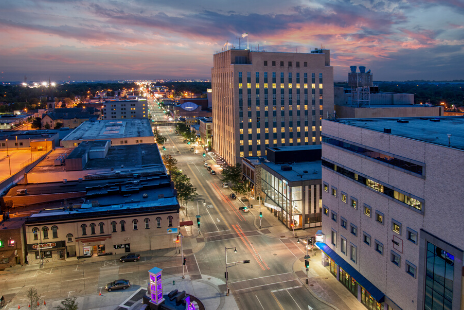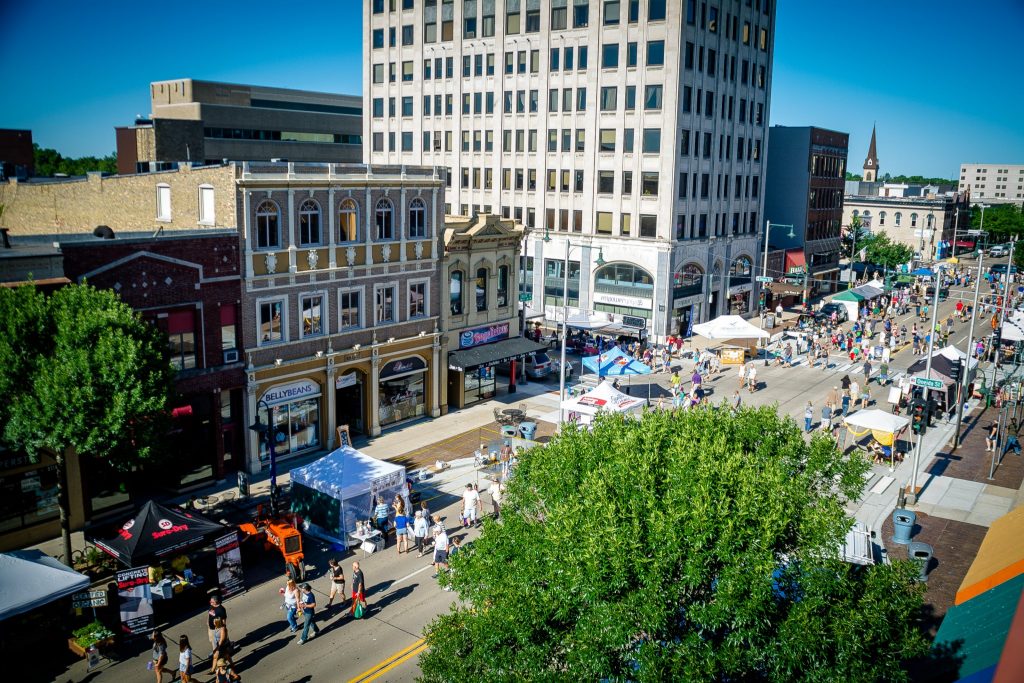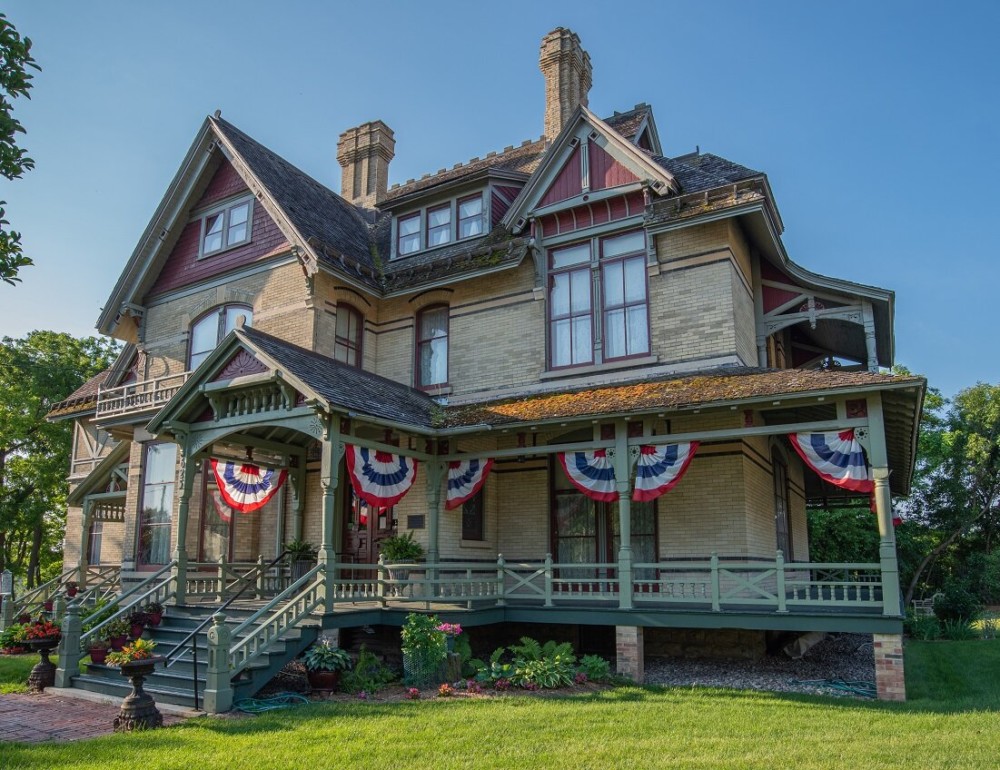A History in the Making: Transforming Perspective in Downtown Appleton
Driving down College Avenue, one notices a shift of perspective as the modern, bustling department stores and restaurants yield to blocks of worn, stoic brick buildings displaying local shops and the vibrant life of downtown Appleton. Passersby replace cars and vans as locals, visitors, or ambitious entrepreneurs and workers stroll or hurry down the sidewalks.

Downtown Appleton is the melting pot of the city’s proudest features. Local specialty shops filled with bright colors and murals and other homemade pieces of pride fill the streets. Yet downtown also features booming business and opportunity and the mighty talents and prestige of the Fox Cities Performing Arts Center (PAC).
To an unfamiliarized onlooker, the shops, restaurants and towering offices might look overwhelming, yet to the locals, it’s the ever-changing, prospering and familiar home of the Fox Cities.
Though it’s familiar today, downtown Appleton has changed drastically throughout the years, most significantly since the 1950s.
To uncover changes in downtown Appleton’s past and discover what triggered the transformation, I turned to the Appleton Historical Society. Two of its members, Dave and Ardyce Buss, gave me the insight I needed as long-time locals of Appleton and its vast history. The story of Appleton can be seen best through the eyes of long-time witnesses, and that is how I wanted to share it with you.
Strolling down the streets, the buildings may seem the same, yet the shops, people and cultural dynamics have certainly transformed over the years.
Some of downtown’s largest contributors to its transformation were the developments of the Paper Valley Hotel (today the Red Lion Hotel Paper Valley), the PAC and the Avenue Mall (today the City Center).
Whether called the Paper Valley Hotel, the Radisson, or now the Red Lion, this massive building took up 13 stores and a full block downtown in the 1990s, but it brought a surge of visitors and business to Appleton.

In a similar fashion, the PAC knocked out a block in 2000, yet stands as one of downtown Appleton’s most prestigious and notable features. Talents and opportunities arose after its opening in 2002, bringing fame, entertainment and a new demand for the nearby businesses.
Consisting mainly of clothing stores before 2000, the block across from the PAC reflects the mystery of downtown Appleton. As the awestruck audience of a magnificent PAC show flooded the streets late at night, bars quickly popped up across the street to meet people’s demands and desires. Downtown Appleton’s shifts have and will continue to meet the demands of the people, ensuring satisfaction and excitement no matter the era.
As the perfect example, the Avenue Mall or City Center Plaza drastically transformed downtown with 22 building removals in March of 1987 to bring the community a popular shopping hotspot and hangout.
However, not all of the changes in Appleton reflected society’s wishes. Part of the motive behind the Avenue Mall was to draw attention away from the west side’s success with the Fox River Mall, built in 1984. Sadly, the Avenue Mall gained the nickname “Johnson Space Center” after the U.S. Johnson Space Center due to its lack of stores. Though the Avenue Mall never gained the fame of its rival, downtown Appleton thrived regardless.
These popular attractions were not the only places changing: nearly all of the stores downtown have switched owners and purposes throughout the years. From the traditional furniture, meat, shoe, book, jewelry and department stores commonly found throughout downtown’s beginning development to specialized boutiques and shops, not much remains the same.
With our modernized society and advancing technology, stores downtown have become more leisure than necessity. People want a taste of local products and want to escape major department stores. Instead of downtown striving to be the hub of all the newest and best, downtown is a breath of fresh air, a glimpse at history, and a place filled with unique and local treasures.
As time advances, the stores are changing faster to meet new demands and keep up with changing customer needs. Ardyce Buss of Appleton Historical Society recalls, “Every year this place was the same, there wasn’t any changing.” Yet now, businesses relocate, sell or transform more rapidly.
For the past generations, this change is shocking, yet David Buss presents an optimistic outlook: “We can feel detached, it’s okay because [the buildings] are all being used. There’s nothing boarded up saying vacant for sale. If you see one, it’s not vacant for long.”

This is true for many of the oldest buildings downtown. Dating back to 1857-Appleton’s founding year- the “Burger King building” as Dave and Ardyce Buss call it, is the oldest historical building downtown and was a Burger King for many years. But now, it holds the new, modern Bowl Ninety-One, an Asian fusion restaurant.
Similarly, the colloquially known “Horsehead building”-nicknamed for the notable statue gracing its roof-was once a horse and saddlery shop yet is now Tusler Law Firm and the hip and trendy Fika Tea Bar.
Other long-lasting buildings include the familiar Heid Music, which has remained in the same family since its opening. Flanagan’s Stop and Shop comes in second with only having two owners and belonging to the Flanagan’s for over 60 years. The more kid-friendly candy store, Crazy Sweet, used to be First National Bank, yet now caters to any sweet tooth.
Even with changing stores, the remaining architecture reflects the preserved cultural ideologies as when downtown was first founded. The same sense of pride for the area radiates through the streets, especially in preserving buildings and history. Downtown continues to raise up optimistic workers, remaining business-motivated during the day and a nightlife hub at night.
Yet with the changing times, many of the past customs and views have shifted tremendously.
Downtown transformed from small stores to massive departments, and now, to a mix of both, signifying the change in consumers, their demands, and the popularity of leisure activities. Ardyce Buss, a small-town girl from Freedom recalls, “[My mother, sisters, and I] didn’t come downtown very often. This was a special thing. before school would start, we’d all get shoes and school clothes.”
Like much of America, Downtown Appleton used to be more of a once-in-a-blue-moon hotspot, a formal occasion, yet now, downtown is a mix: fancy date-nights, important business deals, or a Saturday with friends calls for a visit to downtown, reflecting the blending lines of social class that modern times have produced.
Past generations remember making the special trip to buy clothes and shoes; visiting the theater; have a fancy night out; try polka dancing; hanging at the park. Until the emergence of teens in pop culture in the ’50s and the explosion of technology, society had slower and simpler developments with more focus on local issues and traditions.
Now, people have become much more involved in social change and national issues. The current popularity of thrift stores represents the blending of classes and pop culture influence, taking a once-taboo subject and making it a “trend.”

Though Appleton may not have been the hub for national news, each local and individual story built up the great city we call home. Dave Buss remembers, “When I was a kid, we used to go downtown every Saturday in the summer to the pig fair. They had everything; It was full of farmers selling their produce.” This event paved the way for the first Downtown Appleton Farmers Market in 1992, now the hub of fresh produce, local, handmade treasures, and other delectable foods and lively events.

Moving nationally, right down the street from downtown on Prospect Avenue, the Hearthstone Historic House Museum became the first house in America to fully have an electronically lighted house using the Edison Electric System in 1882.
Whether a small step or a monumental leap, the transformation, preservation and legacies in our Fox Cities have strongly built our area up, allowing individuals to excel. Notable author Edna Ferber, Pittsburgh Steelers halfback Rocky Bleier and illusionist Harry Houdini aren’t the only individuals that Appleton has impacted; all people, past and present, have helped build and been built up by the opportunities and community downtown Appleton has provided.
The past and present generations not only share the bond of a national crisis-the polio epidemic in the ’50s left kids indoors during the summer, much like our COVID-19 lock down-but we share the places, families and the history of the Fox Cities.
Whether from the stoic homes of Neenah’s founders, the lively spots displaying Oshkosh’s community, the preserved ancient lands of High Cliff, or the progressing streets of downtown Appleton, the Fox Cities shines from all impacts and marks left behind.
As the world grows louder with more and more voices, our yearning to make a sound or impact can become hard to bear, yet our voice can radiate from the very places we call home.
As we change the shops, paint the city with murals, or flood the streets with festivals and farmers markets, the voices of the Fox Cities’ locals are being etched into the sturdy brick surrounding them.
Yet even as we change, the beauty of the past before us echoes in those same walls, waiting for us to appreciate from where we have come.










Leave a Comment